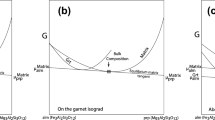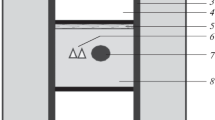Abstract
The consequences of overstepping the garnet isograd reaction have been investigated by comparing the composition of garnet formed at overstepped P–T conditions (the overstep or “OS” model) with the P–T conditions that would be inferred by assuming garnet nucleated in equilibrium with the matrix assemblage at the isograd (the equilibrium or “EQ” model). The garnet nucleus composition formed at overstepped conditions is calculated as the composition that produces the maximum decrease in Gibbs free energy from the equilibrated, garnet-absent, matrix assemblage for the bulk composition under study. Isopleths were then calculated for this garnet nucleus composition assuming equilibrium with the matrix assemblage (the EQ model). Comparison of the actual P–T conditions of nucleation (the OS model) with those inferred from the EQ model reveals considerable discrepancy between the two. In general, the inferred garnet nucleation P–T conditions (the EQ model) are at a lower temperature and higher or lower pressure (depending on the coexisting calcic phase(s)) than the actual (OS model) nucleation conditions. Moreover, the degree of discrepancy increases with the degree of overstepping. Independent estimates of the pressure of nucleation of garnet were made using the Raman shift of quartz inclusions in garnet (quartz-in-garnet or QuiG barometry). To test the validity of this method, an experimental synthesis of garnet containing quartz inclusions was made at 800 °C, 20 kbar, and the measured Raman shift reproduced the synthesis conditions to within 120 bars. Raman band shifts from three natural samples were then used to calculate an isochore along which garnet was presumed to have nucleated. Model calculations were made at several temperatures along this isochore (the OS model), and these P–T conditions were compared to those computed assuming equilibrium nucleation (the EQ model) to estimate the degree of overstepping displayed by these samples. A sample from the garnet isograd in eastern Vermont is consistent with overstepping of around 10 degrees and 0.6 kbar (affinities of around 2 kJ/mole garnet). A sample from the staurolite–kyanite zone in the same terrane requires overstepping of around 50 °C and 2–5 kbar (affinities of around 10–18 kJ/mole garnet). A similar amount of overstepping was inferred for a blueschist sample from Sifnos, Greece. These results indicate that overstepping of garnet nucleation reactions may be common and pronounced in regionally metamorphosed terranes, and that the P–T conditions and paths inferred from garnet zoning studies may be egregiously in error.












Similar content being viewed by others
References
Ashley KT, Caddick MJ, Steele-MacInnis MJ, Bodnar RJ, Dragovic B (2014) Geothermobarometric history of subduction recorded by quartz inclusions in garnet. Geochem Geophys Geosyst 15:350–360. doi:10.1002/2013GC005106
Dragovic B, Samanta LM, Baxter EF, Selverstone J (2012) Using garnet to constrain the duration and rate of water-releasing metamorphic reactions during subduction: an example from Sifnos, Greece. Chem Geol 314–317:9–22. doi:10.1016/j.chemgeo.2012.04.016
Enami M, Nishiyama T, Mouri T (2007) Laser Raman microspectrometry of metamorphic quartz: a simple method for comparison of metamorphic pressures. Am Mineral 92:1303–1315. doi:10.2138/am.2007.2438
Gaidies F, Pattison DRM, de Capitani C (2011) Toward a quantitative model of metamorphic nucleation and growth. Contrib Mineral Petrol 162:975–993. doi:10.1007/s00410-011-0635-2
Guiraud M, Powell R (2006) P–V–T relationships and mineral equilibria in inclusions in minerals. Earth Planet Sci Lett 244:683–694. doi:10.1016/j.epsl.2006.02.021
Hemley RJ (1987) Pressure dependence of Raman spectra of SiO2 polymorphs: a-quartz, coesite, and stishovite. In: Manghnani MH, Syono Y (eds) High-Pressure Research in Mineral Physics. Terra Scientific, Tokyo/American Geophysical Union, Washington, pp 347–359
Kohn MJ (2013) “Geoba-Raman-try”: calibration of spectroscopic barometers for mineral inclusions. Paper presented at the AGU 2013 fall meeting, San Francisco
Kohn MJ (2014) “Geoba-Raman-try”: calibration of spectroscopic barometers for mineral inclusions. Earth Planet Sci Lett 388:187–196
Lasaga AC (1986) Metamorphic reaction-rate laws and development of isograds. Mineral Mag 50:359–373. doi:10.1180/Minmag.1986.050.357.02
Lasaga AC, Rye DM (1993) Fluid flow and chemical reaction kinetics in metamorphic systems. Am J Sci 293:361–404
Manning CE, Ingebritsen SE, Bird DK (1993) Missing Mineral Zones in Contact Metamorphosed Basalts. Am J Sci 293:894–938
Menard T, Spear FS (1994) Metamorphic P-T paths from calcic pelitic schists from the Strafford Dome, Vermont. J Metamorph Geol 12:811–826
Pattison DRM, Seitz JD (2012) Stabilization of garnet in metamorphosed altered turbidites near the St. Eugene lead–zinc deposit, southeastern British Columbia: equilibrium and kinetic controls. Lithos 134–135:221–235. doi:10.1016/j.lithos.2011.12.007
Pattison DRM, Tinkham DK (2009) Interplay between equilibrium and kinetics in prograde metamorphism of pelites: an example from the Nelson aureole, British Columbia. J of Metamorph Geol 27:249–279
Pattison DRM, De Capitani C, Gaidies F (2011) Petrological consequences of variations in metamorphic reaction affinity. J Metamorph Geol 29:953–977. doi:10.1111/j.1525-1314.2011.00950.x
Ridley J, Thompson AB (1986) The role of mineral kinetics in the development of metamorphic microtextures. In: Walther JV, Wood BJ (eds) Fluid-rock interactions during metamorphism. Springer, New York, pp 80–97
Rubie DC (1998) Disequilibrium during metamorphism: the role of nucleation kinetics. Geol Soc Spec Publ 138:199–214. doi:10.1144/Gsl.Sp.1996.138.01.12
Schmidt C, Ziemann MA (2000) In-situ Raman spectroscopy of quartz: a pressure sensor for hydrothermal diamond-anvil cell experiments at elevated temperatures. Am Mineral 85:1725–1734
Spear FS, Menard T (1989) Program GIBBS: a generalized Gibbs method algorithm. Am Mineral 74:942–943
Spear FS, Pyle JM (2010) Theoretical modeling of monazite growth in a low-Ca metapelite. Chem Geol 266:218–230
Spear FS, Peacock SM, Kohn MJ, Florence FP, Menard T (1991) Computer programs for petrologic P–T–t path calculations. Am Mineral 76:2009–2012
Walther JV, Wood BJ (1984) Rate and mechanism in prograde metamorphism. Contrib Miner Petrol 88:246–259
Waters DJ, Lovegrove DP (2002) Assessing the extent of disequilibrium and overstepping of prograde metamorphic reactions in metapelites from the Bushveld Complex aureole, South Africa. J Metamorph Geol 20:135–149. doi:10.1046/J.0263-4929.2001.00350.X
Wilbur DE, Ague JJ (2006) Chemical disequilibrium during garnet growth: Monte Carlo simulations of natural crystal morphologies. Geology 34:689–692. doi:10.1130/G22483.1
Zeh A, Holness MB (2003) The effect of reaction overstep on garnet microtextures in metapelitic rocks of the Ilesha Schist belt, SW Nigeria. J Petrol 44:967–994. doi:10.1093/Petrology/44.6.967
Acknowledgments
This work was supported in part from NSF Grant no. 1321777 (Spear) and the Edward P. Hamilton Distinguished Scientist Chair (Spear). The authors thank Brendan Anzures and Michael Gurette for assistance in sample preparation and collection of Raman spectra and constructive reviews from D. Pattison and an anonymous reviewer.
Author information
Authors and Affiliations
Corresponding author
Additional information
Communicated by T. L. Grove.
Rights and permissions
About this article
Cite this article
Spear, F.S., Thomas, J.B. & Hallett, B.W. Overstepping the garnet isograd: a comparison of QuiG barometry and thermodynamic modeling. Contrib Mineral Petrol 168, 1059 (2014). https://doi.org/10.1007/s00410-014-1059-6
Received:
Accepted:
Published:
DOI: https://doi.org/10.1007/s00410-014-1059-6




